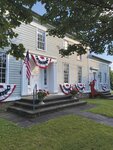
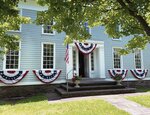
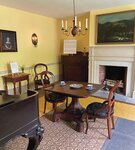
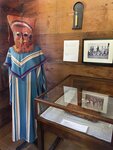
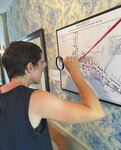
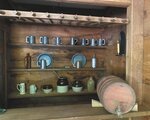

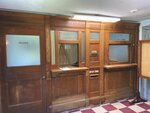

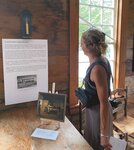
The Hunting Tavern Museum, home to the Andes Society for History and Cultural (ASHC), reopened in 2022 with a fresh new look. ASHC’s all-volunteer board worked industriously, sprucing up rooms housing the hamlet’s historical collections and raising funds for improvements. The museum has a new roof and its wheelchair ramp has been completed.
“Our town has a great story to tell,” observes Joanne Warner, ASCH Board president. The Hunting Tavern Museum is where that story unfolds. For over 200 years, it has played a key role in the life of the Andes community,” she adds. It has worn many hats - as a tavern, a hotel, a stagecoach stop, a home, a hardware store, an apartment house and now, a museum. It was time to add a new chapter to the story.”
The Hunting Tavern, as we know it today – a spacious two-level gray clapboard structure built in the 1820s - had nothing to do with hunting – a popular misconception. The tavern was named after the Hunting family who purchased it in 1838, operating it as both a tavern and hotel. The Delaware-Esopus Turnpike, now Andes’ Main Street, provided the tavern with steady business. The stagecoach stopped three times a week, carrying weary travelers in need of respite and mail that villagers picked up at the tavern. More than a century and a half later, The Gladstone family – Walter, his wife Patricia and Edna Gladstone Benedict - gifted the tavern to the ASHC. A dedication ceremony, held in 1999, marked the official opening of the Hunting Tavern as a museum and as a venue for cultural events.
Over the July Fourth weekend in 2022, 50 visitors walked through rooms where affluent patrons dined and entertained guests over two centuries ago. They took in a display cabinet containing 17th century artifacts from the museum’s earliest predecessor - a one-room log tavern structure, built on the same plot where the museum is today. Visitors climbed the stairs to the large second-floor room used for dances and sleeping quarters in the 1800s. The original swinging doors that dropped down from the ceiling at night to separate the room into male and female sleeping areas, are still there.
This room is also where Delaware County Undersheriff Osborn Steele hid from anti-rent protesters dressed as Calico Indians in the spring of 1845. A portrait of Steele that hung in the Delaware County Courthouse is on view in the museum’s taproom. It was here that Steele had his last drink before riding off to oversee the sale of livestock at the Moses Earle farm, saying, “Lead cannot penetrate Steele.” He was fatally shot and his body brought back to the tavern.
The taproom, now devoted to the Anti-Rent War, houses a framed contract signed in 1824 by Janet Montgomery, wife of General Robert Montgomery, who died in the Revolutionary War. Large tracts of land in the Catskills, such as the 20,000 acres that Mrs. Montgomery inherited from her father, were granted to wealthy land barons by King George of England. The barons rented the parcels to settlers who farmed them - often barely eking out a living.
The farmers had to pay a yearly rent and give part of their harvest and produce to the landlord. If farmers couldn’t meet rent payments, local law enforcement was called in to oversee the forced sale of their land. Discontent erupted among the farmers. Anti-Rent societies were formed to try to prevent officials from carrying out their duties. They adopted Indian costumes in the spirit of the 1776 Boston tea party rebels, and wore leather masks. Two original 1845 masks and a Calico Indian costume from the 1976 Anti-Rent reenactment are on display in the taproom. A tin horn, used to warn protesters that the sheriff was coming, is a recent museum acquisition.
“It is fascinating how all of the different pieces from different historical periods have come together to tell the Andes story,” notes Warner, who served as curator of the Wallcoverings Collection at the Cooper Hewitt Smithsonian Design Museum in New York City before moving to Andes.
It was there that she first met ASHC board member Linda Dunne, who served as deputy director before relocating to Andes as well. Working collaboratively with other volunteers, Warner and Dunne began to update the Hunting Tavern Museum’s content - reappointing furnishings and refreshing gallery spaces.
Rooms were organized with exhibits pertaining to each period in Andes history - from its earliest tavern days to the building of the Pepacton Reservoir in the 1950s. The reservoir would bring much-needed water to the growing population of New York City at great expense to the villages that were demolished and its residents relocated. Vintage photographs of these “lost villages,” are now located upstairs in the museum, as are dairy and tool exhibits that speak to Andes’ farming past.
In 1953, the post office interior was removed intact from the corner building it occupied and donated by the U.S. Postal Service to ASHC. It, too, can be visited in its permanent home on the second floor.
New signage by Warner, with input from Andes resident and long term ASHC board member Jim Andrews, guides visitors through the museum, giving a better insight into the events that shaped the hamlet. Each room now has signs that tell a story as to how the room was used long ago. Individual labels next to exhibits make the viewing of paintings, maps, exhibits, furnishings and décor more meaningful.
Magnifying glasses have been installed next to vintage maps to help visitors view and study them more closely. “People are enjoying the new signs,” observed volunteer Sarah Lewis, who contributed one of the earliest maps of Andes (circa 1856) on display in the entrance hallway. “They stay longer than before, reading the signs and taking in their historical content.”
One of the first rooms to enjoy a makeover was the front parlor. Shards of glass from tumblers and pieces of flow blue chinaware dating to the 1800s were among the artifacts uncovered in the 1999 archaeological survey undertaken by students of SUNY Binghamton.
“Dug up from underneath this room, they support the fact that the parlor was used for dining during this period,” says Dunne. One can picture Duncan Ballantine and Henry Dowie, leading Andes citizens in the 1800s, enjoying a meal with their families and friends, served on this fine china. The Italianate mansion that Ballantine built still sits off Main Street.”
A trip made by volunteers to the Pleasant Valley Meeting House, also owned by the Andes Society for History & Culture, yielded an 1800s rug below the present carpet. It fit in perfectly with the rooms’ 19th century furnishings and décor. Upon further research, the rug turned out to be an example of the first machine-made reversible rugs from that period. Volunteers took up paint brushes to give the parlor a fresh coat of yellow paint that bathes the room in a warm glow.
Additional acquisitions from donors are located in the museum’s main room and are part of its expanded collections on view. They include a gift of a charming, hand-tinted lithographic print called Home & Family (circa 1845), donated by Andes residents Vera and Donald Liddle.
A focal point in the main room is another new acquisition - an Empire style chest of drawers, made locally by Howe & Jarvis cabinetmakers of Delhi (1834-1838), and restored by ASHC.
The Geiger family contributed the “Snag Proof Boots” advertisement from the J.W. Dickson store, circa 1935. The poster had been purchased by the late Ann Geiger, an ASHC founder, for her Andes home. This store, known as the Big Store on the corner of Main Street and Delaware Avenue, is now home to WillBees. William Elwood, born and raised in Shavertown, donated a 1963 aerial photo revealing the remains of this village, lying underneath the Pepacton Reservoir. A wool “Tumbling Blocks” quilt from the 19th century, and a cotton summer coverlet from the same period are among recent acquisitions.
The Museum is open Saturdays from 11 a.m.-4.p.m. through the October Columbus Day weekend.
A local resident visiting with out-of-town guests summed up the new look this way: “It’s like visiting a whole new museum. It’s very impressive.”